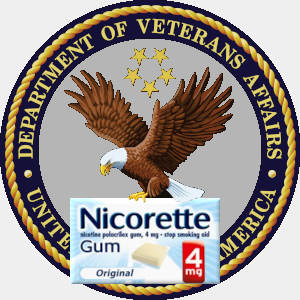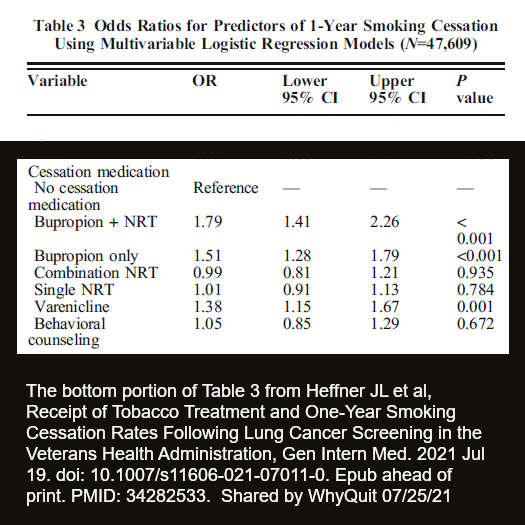
Single and combo NRT ineffective among 5,589 screened Veterans
Once again, headline news from a stop smoking study was omitted from the study's abstract.

A smoker’s first-ever lung cancer screening should be a highly teachable moment, especially if it includes a low-dose CT scan. But what if the quit smoking method prescribed—replacement nicotine—is itself a roadblock?
Researchers examined one-year Veteran stop smoking rates following lung cancer screening. They found that, compared to Veterans receiving no approved quitting products, there was no increase in the odds of successful cessation among 4,440 Veterans who received single forms of nicotine replacement therapy (NRT: the nicotine patch, gum, lozenge, spray or inhaler) or among 1,189 who received combination forms of NRT.[1]

Published on July 19, 2021 in the Journal of General Internal Medicine, the VA study’s authors found the NRT findings “surprising,” noting that they are “provocative and warrant an additional evaluation in the context of a randomized, controlled trial that evaluates effectiveness for cessation as well as cost-effectiveness.”[1]
It’s a population-level NRT ineffectiveness finding that’s become common.[2]. It’s so common that in 2020 the U.S. Surgeon General’s smoking cessation report reluctantly acknowledged that most real-world ex-smokers succeed by quitting cold turkey and at rates equal or superior to those using over-the-counter NRT products.[3|
The new VA study did find increases in the odds of success over no medication for Chantix (38%), Zyban (51%) and Zyan + NRT (79%).[1]
Missing is the actual data related to “no medication” quitters, including a breakdown of the two primary types, abrupt nicotine cessation and gradual weaning.
The study relied upon Veterans Administration (VA) electronic medical records of 47,609 current smokers who underwent lung cancer screening, who received a low-dose CT between January 2014 and June 2018, and who had at least 18 months of post-screening medical care.[1]
Only 8,702 (18.3%) of the 47,609 screened smokers received approved quitting products or behavioral treatment. While the study found an overall 11.3% quitting rate among approved product users, study readers are left in darkness as to the quitting rate of the 38,907 Vets (81.7%) who didn’t use approved products, a large percentage of whom likely attempted quitting on their own. And it matters.
A January 2021 study found that 115 of 151 smokers with bladder cancer attempted quitting, with most attempting cold turkey (63 of 115 or 54%), and most succeeding cold turkey (42 of 64 or 66%).[4]
VA Behavioral Counseling
Also troubling from the new VA study is the finding that VA behavioral counseling is only 5% more effective than quitting without it (OR 1.05 95% CI).
One of the VA’s primary behavioral resources is a 96-page booklet entitled "My Tobacco Cessation Workbook." While most topics are well researched, here’s a brief overview of troubling aspects.[5]
Last revised in April 2017, overall, the workbook is tailored to support the 18.3% in the new VA study who used approved products. In fact, "cold turkey," the method that each year helps more nicotine dependent Vets arrest their chemical dependence than all other methods combined, isn't mentioned.
Ask yourself, what is the primary reason why smokers smoke, why e-cig users vape, and why smokeless tobacco users dip? Page 4 is entitled “Why do I use tobacco products?” It lists 10 reasons to pick from. Guess which reason is missing? Yep, you guessed it, “Because I’m addicted.”
Although page 18 is entitled "Nicotine Addiction" it reads more like a nicotine sales pitch.
Readers are told that “Nicotine is a substance found naturally in tobacco that causes feelings of pleasure, relaxation or stimulation, and stress reduction. Nicotine is the addictive part of tobacco, but is not by itself harmful to your body.”
Actually, nicotine is a poison, a natural insecticide, the synthetic versions of which (neonicotinoids) are the world's most widely used farm insecticides.
As reviewed by a 2015 study, "Nicotine poses several health hazards. There is an increased risk of cardiovascular, respiratory, gastrointestinal disorders. There is decreased immune response and it also poses ill impacts on the reproductive health. It affects the cell proliferation, oxidative stress, apoptosis, DNA mutation by various mechanisms which leads to cancer. It also affects the tumor proliferation and metastasis and causes resistance to chemo and radio therapeutic agents."[6]
As for pleasure, relaxation and stress reduction, the workbook misses a golden opportunity to set the record straight.
Declaring the satisfaction of urges and cravings for nicotine "pleasure" is akin to saying that it feels good to stop pounding your finger with a hammer. As for relaxation, nicotine is a stimulant that prepares the body for fight or flight, including making the heart pound up to 18 beats per minute faster.
As for stress reduction, never once has nicotine changed a flat tire or paid a bill. As reviewed in a once-secret 1983 Brown & Williamson Tobacco Company research memo and supported by research,[7] "People smoke to maintain nicotine levels" and "stress robs the body of nicotine, implying a smoker smokes more in times of stress due to withdrawal, not to relax."
Page 18 is fully in tune with page 30 where smokers are taught that nicotine is "medicine" and its use "therapy." Page 40 is also in harmony in suggesting that smokers resist the sudden impulse and urge to quit and instead set a quit date. While unplanned attempts are up to 2.4 times more successful,[8] setting a date allows time to locate, purchase and begin use of approved quitting products.
Despite the risk of maintaining/reinforcing psychological hand-to-mouth aspects of nicotine dependence,[9] pages 44 and 47 encourage quitters to identify and use smoking substitutes such as straws, stir sticks and sugar-free candy.
Lastly, page 66 is entitled "Slip Prevention." There, readers are led to believe that slips are normal and easily correctable. "Don’t get discouraged! One cigarette or dip is better than having a whole pack or can."
While non-harmful advice for NRT quitters, where each NRT use is effectively a nicotine lapse, what about the giant elephant in the room, the majority of quitters who stopped stimulating their dopamine pathways via nicotine or other partial agonists? Wouldn't a far safer message be "don't slip"?
The 1990 Brandon lapse/relapse study found that "The high rate of return to regular smoking (88%) once a cigarette is tasted suggests that the distinction between an initial lapse and full relapse may be unnecessary."[10] Also see Garvey 1992, where 95 percent of lapses led to relapse. [11]
Hopefully, this study will be a wake-up call within the VA, including smoking cessation policymakers rethinking putting nearly all their cessation eggs in the nicotine weaning basket.
Reflection is also needed on the cessation counseling needs of approved product quitters versus cold turkey quitters. Where is the harm in having two different nicotine dependency recovery booklets, one dedicated to weaning a4b2-type acetylcholine receptors off of nicotine and the other to abrupt nicotine cessation?
References
1. Heffner JL, Coggeshall S, Wheat CL, Krebs P, Feemster LC, Klein DE, Nici L, Johnson H, Zeliadt SB. Receipt of Tobacco Treatment and One-Year Smoking Cessation Rates Following Lung Cancer Screening in the Veterans Health Administration. J Gen Intern Med. 2021 Jul 19. doi: 10.1007/s11606-021-07011-0. Epub ahead of print. PMID: 34282533.
2. Pierce JP, Gilpin EA. Impact of over-the-counter sales on effectiveness of pharmaceutical aids for smoking cessation. JAMA. 2002 Sep 11;288(10):1260-4. doi: 10.1001/jama.288.10.1260. PMID: 12215133; also see, Kotz D, Brown J, West R. Prospective cohort study of the effectiveness of smoking cessation treatments used in the "real world". Mayo Clin Proc. 2014 Oct;89(10):1360-7. doi: 10.1016/j.mayocp.2014.07.004. PMID: 25282429; PMCID: PMC4194355; also see Weaver SR, Huang J, Pechacek TF, Heath JW, Ashley DL, Eriksen MP (2018) Are electronic nicotine delivery systems helping cigarette smokers quit? Evidence from a prospective cohort study of U.S. adult smokers, 2015–2016. PLoS ONE 13(7): e0198047. https://doi.org/10.1371/journal.pone.0198047 (see Table 7); also see Pierce JP, Benmarhnia T, Chen R, White M, Abrams DB, Ambrose BK, et al. (2020) Role of e-cigarettes and pharmacotherapy during attempts to quit cigarette smoking: The PATH Study 2013-16. PLoS ONE 15(9): e0237938. https://doi.org/10.1371/journal.pone.0237938.
3. USDHHS. Smoking Cessation. A Report of the Surgeon General. Atlanta, GA: U.S. Department of Health and Human Services, Centers for Disease Control and Prevention, National Center for Chronic Disease Prevention and Health Promotion, Office on Smoking and Health, 2020 (see page 15).
4. Bassett JC, Matulewicz RS, Kwan L, McCarthy WJ, Gore JL, Saigal CS. Prevalence and Correlates of Successful Smoking Cessation in Bladder Cancer Survivors. Urology. 2021 Jan 13:S0090-4295(21)00047-9. doi: 10.1016/j.urology.2020.12.033. Epub ahead of print. PMID: 33450283
5. Himstreet J, U.S. Department of Veterans Affairs. My Tobacco Cessation Workbook: A Resource for Veterans. Revised April 2017. IB 10-564; P96621
6. Mishra A, Chaturvedi P, Datta S, Sinukumar S, Joshi P, Garg A. Harmful effects of nicotine. Indian J Med Paediatr Oncol. 2015;36(1):24-31. doi:10.4103/0971-5851.151771; also see Ginzel KH, Maritz GS, Marks DF, Neuberger M, Pauly JR, Polito JR, Schulte-Hermann R, Slotkin TA. Critical review: nicotine for the fetus, the infant and the adolescent? J Health Psychol. 2007 Mar;12(2):215-24. doi: 10.1177/1359105307074240. PMID: 17284486.
7. Schachter, S., Silverstein, B., Kozlowski, L. T., Herman, C. P., & Liebling, B. (1977). Studies of the interaction of psychological and pharmacological determinants of smoking: IV. Effects of stress on cigarette smoking and urinary pH. Journal of Experimental Psychology: General, 106(1), 24–30. https://doi.org/10.1037/0096-3445.106.1.24; also see Benowitz NL, Jacob P 3rd. Nicotine renal excretion rate influences nicotine intake during cigarette smoking. J Pharmacol Exp Ther. 1985 Jul;234(1):153-5. PMID: 4009497.
8. Ferguson SG, Shiffman S, Gitchell JG, Sembower MA, West R. Unplanned quit attempts--results from a U.S. sample of smokers and ex-smokers. Nicotine Tob Res. 2009 Jul;11(7):827-32. doi: 10.1093/ntr/ntp072. Epub 2009 Jun 9. PMID: 19509277; also see West R, Sohal T. "Catastrophic" pathways to smoking cessation: findings from national survey. BMJ. 2006 Feb 25;332(7539):458-60. doi: 10.1136/bmj.38723.573866.AE. Epub 2006 Jan 27. PMID: 16443610; PMCID: PMC1382540.
9. Rupprecht LE, Smith TT, Schassburger RL, Buffalari DM, Sved AF, Donny EC. Behavioral mechanisms underlying nicotine reinforcement. Curr Top Behav Neurosci. 2015;24:19-53. doi:10.1007/978-3-319-13482-6_2
10. Brandon TH, Tiffany ST, Obremski KM, Baker TB. Postcessation cigarette use: the process of relapse. Addict Behav. 1990;15(2):105-14. doi: 10.1016/0306-4603(90)90013-n. PMID: 2343783.
11. Garvey AJ, Bliss RE, Hitchcock JL, Heinold JW, Rosner B. Predictors of smoking relapse among self-quitters: a report from the Normative Aging Study. Addict Behav. 1992;17(4):367-77. doi: 10.1016/0306-4603(92)90042-t. Erratum in: Addict Behav 1992 Sep-Oct;17(5):513. PMID: 1502970.

